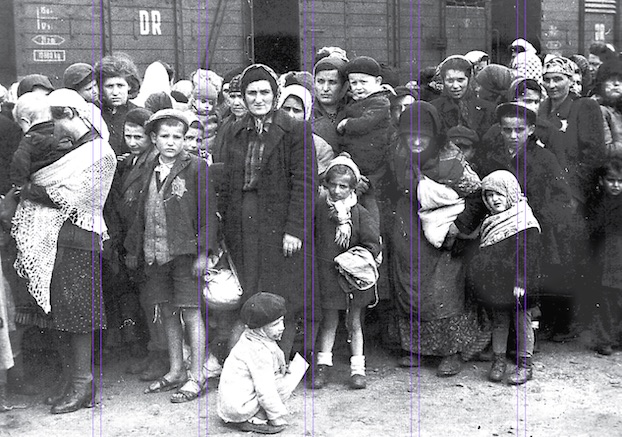‘How do you describe hell?’ : Retired McNeese history professor offers insight into how, why Holocaust happened
Published 9:22 am Sunday, April 23, 2023

- Hungarian Jews arrive at the German Nazi death camp Auschwitz in Poland in the summer of 1944. (Source: Wikimedia Commons)
To honor Yom HaShoah, or Holocaust Remembrance Day, retired McNeese State University Professor of History Dr. Robert Forrest gave two free lectures titled “Surviving the Holocaust.”
The programming was hosted by the Calcasieu Parish Public Library, and took place at the Central and Vinton Branches.
The Holocaust is defined as the “state-sponsored and directed mass murder of a designated group or groups with the intention of completely exterminating that group” Forrest said.
Trending
Between 1933 and 1945, approximately 11 million people were murdered by the Nazi regime.
While the Germans came into power in 1933, the Holocaust itself lasted about 21 months, from early spring 1942 to October of 1944.
This was the most fatal period of the Nazi’s anti-semetic regime.
However, most of the survivors were those that we captured during the Holocaust, not before. “Paradoxically, the best chance you have to survive this purge of Jews was to have gotten into it at the very end.”
The escalation to the Holocaust was slow. “There was no original intention to murder the whole world,” Forrest said.
The process began with the placement of Jewish communities in one of the many ghettos that were created by Germany before they were sent to one of 23 major concentration camps and 40,000 sub-concentration camps, with the intention of immigrating the Jewish population into willing countries.
Trending
However, no other country in the world wanted to house Jewish communities. “No one else wanted to take them, saying ‘well, if you don’t want them, we don’t want them… the Nazi’s never really dreamed that the world wouldn’t just take them.”
The international complacency to Germany’s anti-semetic practices led to the conversion of concentration camps into slave labor camps.
When the camps and ghettos became overcrowded, the order for the “final solution,” the institution of death camps, was made.
There is no written record that Hilter made a direct order to begin the Holocaust. “Adolf Hitler’s style of governing was to just make general pronouncements and rarely ever write anything down.”
Any evidence of the kill order lies in the correspondence of Heinrich Himmler, where he gives reports stating “I have been told that we are going to engage in the extermination, or final solution, of the Jewish people,” Forrest said.
Leaning on these anti-semetic beliefs, the Nazi party believed themselves to be saving civilization, with a “focus on securing life on Earth,” said Forrest.
Anti-semetic ideologies run deep in Western culture. “Anti-semetism goes back as far as the seven hundreds before Christ… the Jews are the only people claiming ‘We have the mantra of God. We are the chosen people, and we will not compromise our culture and our way of life in any way,” Forrest explained.
This led to the twelve tribes of Israel being exiled from their land and migrated to different parts of the world, like Western Europe and the Baltic States. “They wandered as nomadic peoples… Jewish people living in isolated neighborhoods, practicing their own way of life.”
Their negative cultural position was exacerbated by the communities’ refusal to convert to Christianity, and began to be considered “the army of Satan,” Forrest said.
These anti-semetic beliefs eventually evolved into a conspiracy that claimed that the “Elders of Zion, elders in this Jewish international community, are planning to take over Western civilization.”
“What then emerges with the Nazi thinking is ‘these people that are scattered among us… will destroy us, so we have to get rid of them as soon as possible,’” he explained.
In Nazi Germany, Jewish populations were a threat to German aryans, a designated population of white, non-Jewish people with blond hair and blue eyes that were considered the superior race that plays a major part of Nazi ideology.
A focus of Forrest’s lecture was the survival of Holocaust victims: Who was most likely to survive? What were the uniting features of Holocaust survivors?
The first steps to survival began in the ghettos, and those steps were to gain power and have money. In an effort to have governing bodies within the ghettos, small systems with Jewish government officials and police force officers were created.
They were immune to transportation to concentration camps. Unfortunately, in return they were expected to choose the people that were transferred. Ultimately, rich members of the Jewish population were able to pay off these officials to secure their safety as well. “So what’s happening is the very rich are buying their way out or obtaining seats in the government so they don’t have to keep paying every time there is a deportation,” Forrest said.
For those that weren’t able to avoid the camps, those who were most likely to survive were young, healthy, cunning enough to get a job inside and lucky.
Most importantly, you have to build community. “You have to find someone who can help you. You can’t survive Auschwitz alone.”
Women were more likely to survive for this reason. Forrest explained that women were more likely to establish these work groups. “They nursed each other. They shared food with each other. They would pool together their resources to get each other jobs inside the warehouses.”
Community brought humanity back to the victims; the entry process – which involved shaving their heads, surrendering their clothing and being assigned a number – was purposefully dehumanizing.
The Holocaust was not a widely studied event until the 1960s.
At the point in time which the concentration camps were liberated, most records, buildings and damning evidence was destroyed. This made it difficult for the world outside the camp to fully understand the atrocities that were committed.
There was also an initial international desire to not address the event. Society was able to turn a blind eye by disconnecting themselves from Nazis.
This was done by dehumanizing them. Forrest recalled his education. “When I was in high school, we were taught that the Nazis were something from Mars, they weren’t really people. ”
However, this changed in the ’60s and ’70s when similar ideologies began to pop up in other areas of the world, such as the cultural revolution in China in the late ’60s.
“We thought maybe there is something that happened in Germany that was maybe more human than we thought.”
It was also difficult to get first hand accounts from survivors due to the sensitivity of the traumatic events they experienced. He cited the attitudes of many survivors.
“It was disintegrating into something that the survivors couldn’t even describe… They said there’s a problem in trying to describe all of this because you’re taken out of civilization and put into hell, and how do you describe hell?”





